Highlights are a transformative art form, breathing vitality and dimension into hair. And this nuanced technique goes beyond mere color application. It’s a personalized expression of style and individuality. From subtle enhancements to bold transformations, mastering the art of highlighting placement is essential for stylists seeking to cater to their clientele’s diverse and ever-evolving preferences.
This comprehensive guide aims to offer a deep dive into the intricate world of highlighting techniques to unravel the secrets of their applications and effects. With this valuable information in hand, you’ll be prepared to approach each client with creativity, confidence and an understanding of the vast possibilities that highlights offer. Let’s go!
Types of Highlights
Whether you’re a new colorist or you’re a seasoned stylist eager to stay up to date with the latest techniques, discover the most popular different types of highlights below.
Traditional Foil Highlights
The traditional foil method is the standard in the expansive domain of hair highlighting. This time-honored technique represents a marriage of technical finesse and artistic craftsmanship. In this process, stylists isolate small, strategically chosen sections of hair within individual foil packets. This deliberate approach ensures exceptional accuracy, producing clean lines and a polished finish that seamlessly integrates with the natural hair. The foil keeps the hair lightener from bleeding and allows for a controlled transformation.
Beyond its technical merits, the traditional foil method is a testament to the stylist’s prowess, demanding an acute understanding of color theory and an innate ability to blend shades seamlessly. For clients, the outcome instills confidence in the stylist’s expertise, offering a timeless and refined look that speaks to sophistication and personal style.
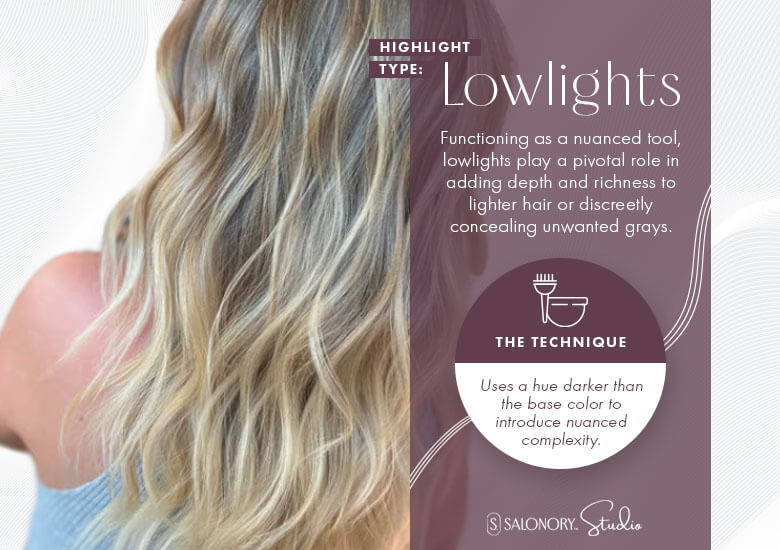
Lowlights
Lowlights, the understated counterpart to their more vibrant sibling highlights, are a masterful technique within the intricate realm of hair coloring. Functioning as a nuanced tool, lowlights play a pivotal role in adding depth and richness to lighter hair or discreetly concealing unwanted grays. This technique uses a hue darker than the base color to introduce nuanced complexity to the overall hair color.
The artistry of lowlights lies in the delicate interplay of tones, where the darker strands seamlessly integrate with the natural hair, creating a visual depth that is both sophisticated and refined. Lowlights, by design, provide a discreet yet powerful enhancement that elevates the overall aesthetic. Whether seeking to infuse warmth into a blonde canvas or create a multi-dimensional effect, lowlights testify to the stylist’s ability to wield professional hair color with finesse, revealing a subtle beauty that unfolds with every strand.
Face Framing Highlights
Face framing highlights are a great option for clients who desire to accentuate their facial features. This method, akin to a painter delicately highlighting the focal points of a masterpiece, involves strategically placing highlights around the hairline and cheekbones. The result is a meticulously crafted framing effect that draws attention to the face and enriches its natural contours.
Beyond the technical precision, face framing highlights contribute to an aesthetic that transcends the ordinary. As the highlights dance along the contours of the face, they brighten and sculpt, enhancing the client’s natural beauty.
Half Head Highlights
The half head highlight technique is a versatile solution for clients seeking a rejuvenated look without the full commitment of an extensive color transformation. This highlighting method strikes a perfect balance and is ideal for anyone who wants to change their appearance subtly. By focusing on the top half of the head, the highlights seamlessly integrate into the natural color, creating a nuanced effect that enhances without overpowering.
Half head highlights are also practical because they provide a low-maintenance option for clients with busy lifestyles. This technique allows for a more gradual regrowth, minimizing the need for frequent touch-ups and ensuring a timeless look that fits the client’s lifestyle. Half head highlights embody practicality without compromising style, giving clients a hassle-free approach to hair transformation.
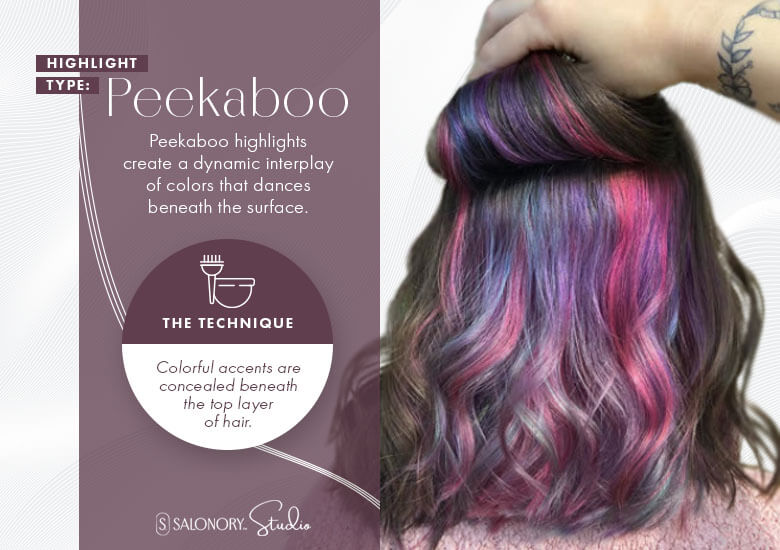
Peekaboo Highlights
Peekaboo highlights inject playfulness and surprise into hairstyling, providing clients with a unique avenue to express their creativity. These colorful accents are concealed beneath the top layer of hair to form a fun secret waiting to be unveiled. Often executed in vibrant or contrasting shades, peekaboo highlights create a dynamic interplay of colors that dances beneath the surface. These hidden accents reveal themselves as the hair moves and shifts, creating a lively effect.
The versatility of peekaboo highlights allows clients to embrace their adventurous side without fully committing to an all-over color change. Peekaboo highlights offer limitless possibilities, whether opting for bold, electric hues or subtle, complementary tones.
Ribbon Highlights
Ribbon highlights are a bolder option that transcends conventional norms to create a visually striking effect through the artful alternation of thick and thin highlight sections. By creating highlights of various widths, you can infuse a sense of dynamism into the hair in a natural-looking way.
Pintura Highlights
The pintura highlighting technique is a revolutionary departure from traditional approaches that introduces an artful freehand application and transforms hair into a canvas for creative expression. With the adept use of a brush, stylists wield precision and control to achieve a soft and natural look, seamlessly blending colors with unparalleled finesse. Pintura highlights are more than a simple color application. They are a testament to your artistic prowess as a colorist.
The freehand nature of pintura highlights allows for a customized approach, ensuring that each brush stroke reflects the client’s unique features and personal style. The effect mimics the play of sunlight on hair, creating a radiant and effortlessly beautiful finish.
Babylights
Babylights, characterized by their delicacy and ultra-fine nature, are a refined approach to capturing the natural brightness of childhood hair. Much like the gentle caress of sunlight on a clear day, babylights have a subtle, natural appearance. These highlights are particularly adept at seamlessly blending harsh lines, providing a smooth transition between colors and enhancing the hair’s overall texture.
The delicacy of babylights makes them ideal for those seeking to introduce a touch of brightness without overwhelming the entire look. They are a graceful addition to any hairstyle, evoking a sense of timeless beauty reminiscent of the carefree days of childhood.
Teasy Lights
Teasy lights offer a textured and dimensional approach to hair highlighting. This technique introduces a captivating element achieved by strategically teasing hair sections before applying highlights. The teasing contributes to increased volume and sets the stage for a controlled drama that defines teasy lights.
By blending the precision of highlights with the organic texture created through teasing, this method produces a look that is both dynamic and rich in depth. Teasy lights add complexity to the overall style, infusing an edge of sophistication and creativity into the hair. The effect is a harmonious interplay between light and shadow that creates visual depth and transforms the hair into a multi-dimensional masterpiece.
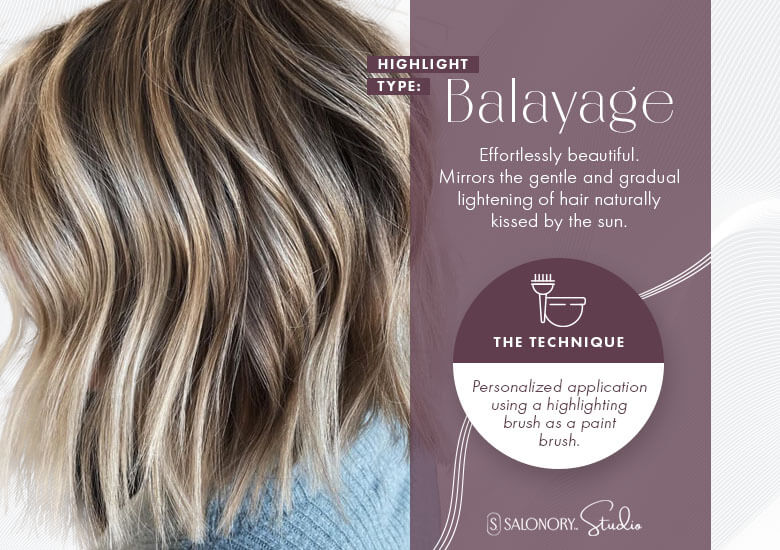
Balayage
Balayage is a hand-painting technique that achieves a sun-kissed gradient effect. Using a highlighting brush as a paint brush, this method allows for an organic and personalized application. Balayage celebrates subtlety, artfully eliminating harsh lines and stark contrasts common in traditional highlighting techniques. The result is an effortlessly beautiful finish that mirrors the gentle and gradual lightening of hair naturally kissed by the sun.
The inherent versatility of balayage makes it adaptable to various hair lengths, textures and styles. This technique showcases the stylist’s technical proficiency and emphasizes their artistic sensibility, as they paint with precision and intention to enhance the client’s unique features.
Reverse Balayage
Reverse balayage is a dynamic and innovative hair coloring technique that flips the traditional balayage method on its head — quite literally! While classic balayage involves hand-painting lighter tones onto darker hair, reverse balayage adds a playful twist by introducing darker hues onto a lighter canvas. It’s an artistic endeavor in which the colorist strategically places darker shades to create depth, dimension and mesmerizing contrast. It’s a perfect fusion of sophistication and a touch of rebellious charm.
High-Contrast Balayage
High-contrast balayage is designed for individuals with an appetite for bold and dramatic transformations. This technique is a captivating interplay of light and dark shades that delivers a striking transition, creating a visually dynamic effect that immediately captures attention. Unlike more subtle variations, high-contrast balayage thrives on the dramatic juxtaposition of deeply rooted darker tones seamlessly transitioning into radiant, lightened ends. The result is a visually compelling masterpiece that showcases your ability to create dynamic color palettes and allows the client to make a powerful and unforgettable statement with their hair.
This technique is ideal for those who seek to express individuality and confidence through their hairstyle, as the high contrast adds edginess and modernity to the overall look. High-contrast balayage transcends traditional boundaries, providing a bold and fearless option for those who desire a major transformation.
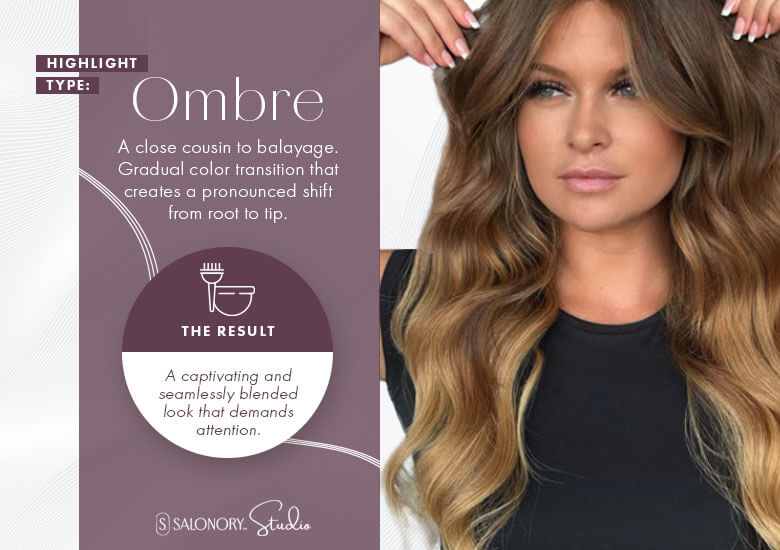
Ombre
Ombre, a close cousin to balayage, takes the concept of gradual color transition a step further, creating a pronounced shift from root to tip. The result is a captivating and seamlessly blended look that demands attention. Ombre also offers a versatile approach to hair coloring, allowing clients to experiment with contrasting shades that add dimension and depth to their overall style. The intentional color shift creates a visually dynamic, striking and alluring effect.
Additional Highlighting Considerations
As you navigate the intricacies of highlighting, several additional considerations come into play, contributing to a comprehensive understanding of the craft.
Balayage vs. Highlighting
The subtle yet profound difference between balayage and traditional foil highlighting includes more than just technical disparities. Each also reflects a stylistic choice. Balayage is a freehand masterpiece where you, the stylist, become an artist painting with sunlight unbound by foils. This technique delivers a softer, more natural look, seamlessly blending hues to mimic sun-kissed strands’ gentle, organic transitions. It is an ode to individuality and fluidity, where each stroke of color becomes a personalized statement.
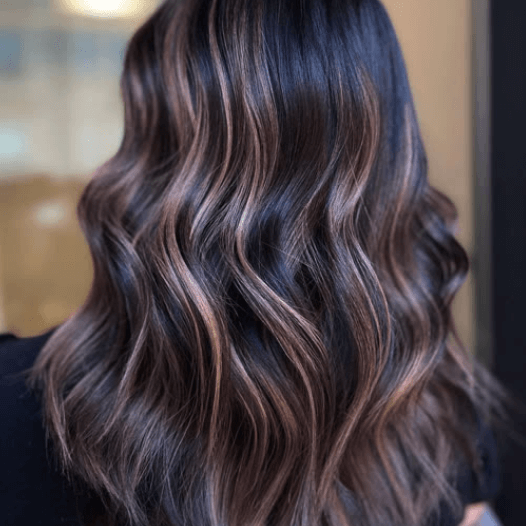
@schwarzkopfpro via Instagram powered by Squarelovin
Conversely, traditional foil highlighting epitomizes precision and control, utilizing foils to accurately isolate sections. This method yields a structured and polished finish with clean lines and defined contrasts that appeal to those desiring a more controlled aesthetic.
Foil Placement
As mentioned previously, careful foil placement allows you to visually increase volume, accentuate specific facial features and create unique effects tailored to each client. The deliberate placement of foils is a multifaceted skill that extends beyond technical proficiency to explore form, balance and creativity. Whether elevating the crown for added volume, framing the face to accentuate certain features or crafting a personalized pattern that tells a visual story, foil placement enables stylists like you to showcase their artistic flair.
Color Upkeep and Maintenance
Empowering clients with an understanding of color upkeep and maintenance is paramount for ensuring a long-lasting and vibrant result in their hair transformation journey. Due to their bold and dramatic nature, the vibrancy and impact of high-contrast highlights and balayage may necessitate more frequent touch-ups than their more subtle counterparts. Educating clients on the individual needs of their unique hair color ensures that they are well informed about the commitment and care required to sustain their chosen color’s brilliance.
From the choice of hair products to the frequency of salon visits, a personalized maintenance plan is integral to preserving the integrity and vibrancy of the color, so be sure to discuss all of these things with your clients. This approach contributes to the desired look’s longevity and enhances the hair’s overall health and condition.
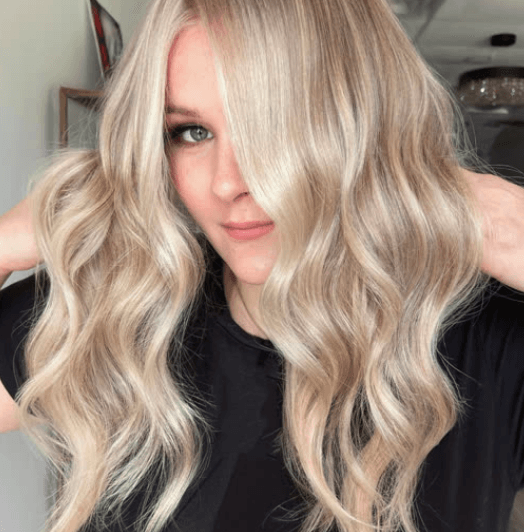
@emilymariestephens via Instagram powered by Squarelovin
A Palette of Possibilities
Mastering the diverse array of highlighting techniques is an essential skill that allows you to transform hair into a personalized work of art. Each technique contributes to your skillset — from the classic precision of traditional foil highlights to the playful intrigue of peekaboo highlights and the sun-kissed allure of balayage. In this guide, we’ve explored the nuances of various methods, emphasizing the importance of understanding client preferences and maintenance considerations. As highlights continue to evolve, we encourage you to approach each client creatively and confidently to ensure that every hair transformation is a unique and tailored masterpiece that enhances natural beauty and individual style.
Image Credits
Flame of life/Shutterstock.com
Rvector/Shutterstock.com
Anastasia Pelikh/Shutterstock.com
hedgehog94/Shutterstock.com






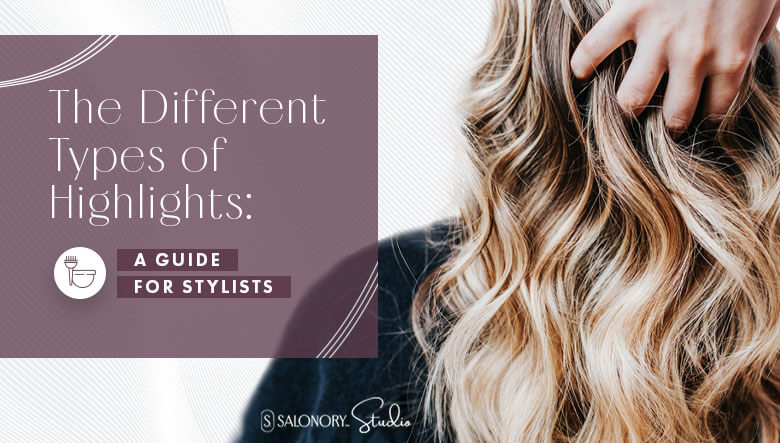







Share Your Feedback